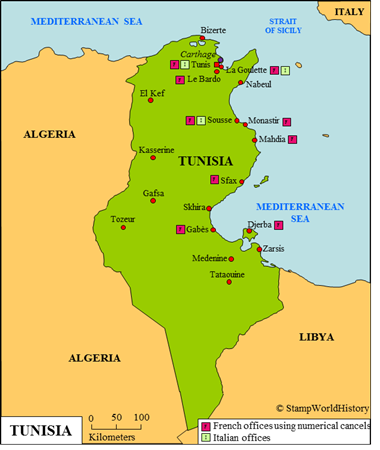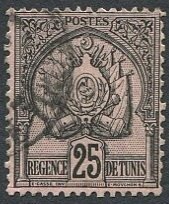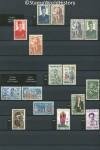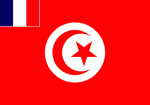
Tunisia
French Protectorate
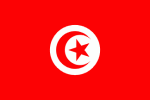
Tunisia
Republic
Quick reference
General issues: French protectorate 1888-1946, French protectorate, associated state 1946-1956, Kingdom 1956-1957, Republic 1957-Present
Country name on general issues: Tunisie, République Tunisienne
Special issues: Germany, army post 1943
Currency: 1 Franc = 100 Centimes 1888-1959, 1 Dinar = 1000 Millièmes 1959-Present
Population: 1 900 000 in 1900, 10 982 000 in 2014
Political history Tunisia
Tunisia as a French protectorate
Tunisia is located in northern Africa. Tunisia has a long history. Having been the seat of Carthage – long one of the major rivals of the Roman Empire – Tunisia, in the second century BC, becomes part of the Roman Empire. In the late 7th century AD Tunisia is conquered by the Arabs – who bring the Arab language, culture and Islam. In the 16th century Tunisia becomes part of the Ottoman Empire. Within the the Ottoman Empire Tunisia is an eyalet, ruled by a bey with a large degree of autonomy. In the 19th century the Ottoman Empire is in decline and the Turkish sovereignty over Tunisia is only nominal.
In the 19th century, France, Italy and, to a lesser extent Great Britain, take an interest in Tunisia. At the 1878 Congress of Berlin – where the European powers are gathered to discuss the shifting balance of power given in the aftermath of the Russo-Turkish War – the French claims to Tunisia find support – as do the Italian claims to Libya and the British claims to Cyprus. In 1881, under the pretext of an armed incursion into French Algeria, the French invade Tunisia and establish a protectorate.
During French rule, the bey is left in position, albeit with only minimal powers. The French stimulate French settlement in Tunisia and invest in infrastructure, education and social development. The European population of Tunisia – French, but also Italian and British – will grow from 10 000 in 1891 to 145 000 in 1946.
During WWII, the Tunisia administration is – as are the administrations of French Algeria and Morocco – loyal to the Vichy regime in France – the Vichy regime collaborating with Germany. In November 1942, the Allies launch Operation Torch to take possession of Algeria and Morocco. Germany responds by occupying Tunisia from neighboring Italian Libya. Having successfully secured Algeria and Morocco, the Allies, later in November 1942, invade Tunisia – by May 1943 the Germans are defeated and withdraw. A Free French administration is now put in place in Tunisia. Directly after WWII, in 1946, the French Empire is reorganized and Tunisia becomes an associated state.
Independent Tunisia
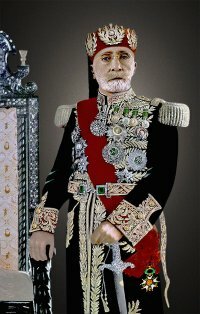
Muhammed VIII al-Amin the last bey of Tunisia.
The call for independence is heard in Tunisia as early as before WWI. The call grows louder in the interbellum, and after WWII, Tunisia inevitably moves toward independence. An amount of self government is granted in 1955. Independence is gained in 1956 as the kingdom of Tunisia. The bey – having used the style of king since 1950 – becomes the first head of state. The kingdom is short lived. In 1957, the bey is deposed and the first premier – Habib Bourguiba, a longstanding protagonist of Tunisian independence – becomes the first president of the republic of Tunisia.
Bourguiba establishes a singe party state and will rule Tunisia until 1987. His successor, Zine El Abidine Ben Ali, will rule Tunisia until 2011 when he is brought down by popular protests – protests that signal the start of the ‘Arab Spring’ which is to spread over the Arab world in subsequent years. A new constitution is agreed upon in 2014, and in the same year multi party elections are held.
The economy of Tunisia is one of the most developed in Africa. It is a diversified market economy with services as the most important sector and manufacturing being the driver for the export – the European Union being the most important trade partner. The population of Tunisia is of mixed Arab, Berber and Turkish origin and is almost fully Arabized. The European community has, by and large, left Tunisia upon independence.
Postal history Tunisia
Postal services before 1888
The bey of Tunisia set up a rudimentary postal service from 1847 – independent from the Ottoman Empire. No stamps were issued for this service. Foreign offices were set up by France and Italy. The first Italian – or rather Sardinian, as this was just prior to the Italian unification in 1861 – post office was opened in Tunis in 1852. Italy was to set up 3 offices in Tunisia. The stamps used were the general issues for use abroad from Italy. The Italian offices closed in 1897. The French also opened their first office in Tunis in 1847. Stamps of France were used from 1862. A second post office is opened in La Goulette using the stamps of France from 1867. From 1881, the French extend the number of post offices – by 1888 a total of 42 post offices has been opened. Stamps of France are used until 1888. Numerical cancels were used in 9 offices.[1]Resources used do not indicate just exactly how mail was handled in the other offices that were set up before 1888: did they use the non numerical cancels that are known to have also been used in Tunisia? Or did they forward mail to the 9 offices as mentioned to be cancelled there? The British consulate processed mail that was forwarded to Malta to be cancelled there.
Postal services after 1888
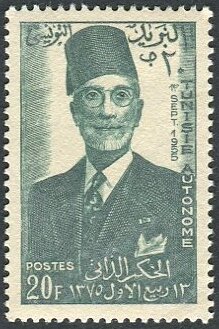
1956 – First issue as independent kingdom commemorating self government granted in 955. Portrait of the bey – then – king of Tunisia Muhammed VIII al-Amin.
A convention signed in 1888 creates the Tunisian Post & Telegraph Office, effectively run by the French – although, strictly speaking, under the authority of the bey. Stamps are issued for Tunisia the same year. The first set shows the coat of arms of Tunisia and is inscribed ‘Régence de Tunis’. Similar stamps are issued until, in 1906, the first set inscribed ‘Tunisie’ is issued. Most stamps issued in the protectorate period are designed especially for Tunisia. A number of stamps issued in France is issued in simultaneously in Tunisia inscribed ‘Tunisie’. The first stamps of independent Tunisia are issued in 1956, commemorating self government granted in 1955, and are inscribed ‘Tunisie Autonome’. It would seem this set was prepared to be issued in 1955, but it was not issued until 1956. The stamps show the portrait of the last bey of Tunisia and an allegory. The first stamps of the republic are issued in 1957, commemorating the proclamation of the republic. Since independence, Tunisia has issued stamps mainly with themes of national interest.
German parcel post admission stamps
During the German occupation in 1943, stamps were issued locally by the German forces in Tunisia. These were parcel post admission stamps. As the means of transport were limited, soldiers were allowed to send only a certain number of parcels for which they were given a corresponding number of stamps. The stamps had to affixed to the parcel in addition to the regular franking required for sending the parcel.[2]These issues are listed in the Michel catalog and referred to in Stanley Gibbons.
Album pages
← Previous page: Tristan da CunhaNext page: Ubangi-Shari →

